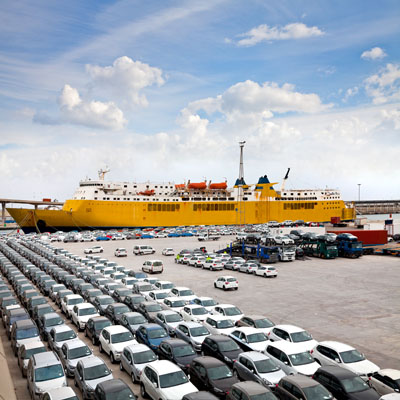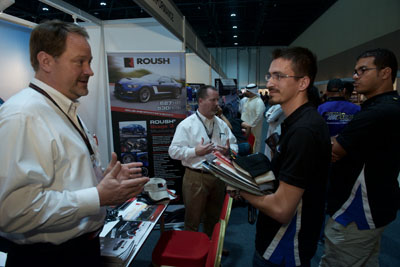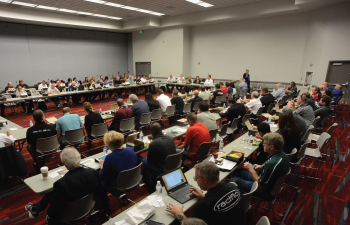SEMA News—March 2016
INTERNATIONAL
It’s a Big World Out There
SEMA Resources for Exporters
 Exporting is a way to reach the 97% of consumers residing outside the United States. SEMA provides you with tools to reach these buyers. |
Why export? One of the proven methods to increasing the health of your firm is to diversify your customer base, which can improve your bottom line, lead to product-improvement ideas and improve a firm’s ability to ride out future economic downturns. It is also the way to reach the 97% of consumers residing outside the United States and take advantage of global demand for products made in the United States.
To narrow down the list of markets to target, consider the following list of criteria for the regions you are targeting:
- Sizable population interested in customizing.
- Discretionary income to afford U.S. specialty-equipment products.
- Vehicle parc (total number of vehicles in the country) that fits your product line or one for which you are willing to make product.
- Legal/regulatory environment allowing vehicle customization.
SEMA Resources
The following resources are available at www.sema.org/international:
SEMA organizes annual Business Development Conferences to China, the Middle East, Australia and Russia: These markets were selected based on the above criteria. In all three markets, U.S. products are highly regarded and sought after, and there is a sufficient enthusiast buyer base seeking the latest specialty-equipment products. These trips provide participants with the opportunity to meet one-on-one with pre-vetted potential partners all in a single venue, and a chance to explore a promising market through an efficient and low-cost program.
Make/Model Data is available for countries throughout the world: The Ford Mustang, the Jeep Wrangler and the Ford F-Series pickup were winners of the 2015 SEMA Award, recognizing the year’s hottest vehicles. Does your company make products for those vehicles? Do you sell your products primarily in the United States? If you answered yes to both of those questions but want to expand your sales outside the United States, SEMA’s make/model data can help you get started by giving you easy-to-use information that will help you identify the best markets in terms of vehicle registrations. Through a joint program with the U.S. Department of Commerce and IHS Automotive, SEMA has compiled the data into a user-friendly resource.
Access to top vehicles customized overseas but not sold in the United States: SEMA, in a partnership with the U.S. Department of Commerce, has the following vehicles available for members to measure in order to create export-ready products:
- ’16 Toyota HiLux
- ’12 Toyota HiLux (CAD data only)
- ’13 Ford Ranger T6 (CAD data only)
- ’14 Mitsubishi L200
- ’14 UAZ Hunter
These vehicles are now available to member manufacturers at the new SEMA Garage in Diamond Bar, California. A vehicle can even be delivered to a SEMA member’s facility for those who need that sort of access.
To sign up to measure a vehicle included in this program, e-mail Jim Moore at jimm@sema.org or call 909-978-6739.
Scan Library
 SEMA organizes annual Business Development Conferences to China, the Middle East, Australia and Russia. At the most recent Business Development Program in China, the SEMA Garage team scanned seven vehicles popularly customized in China but not sold in the United States. The SEMA Garage staff scanned the vehicles and converted the scans to surface and CAD data. |
SEMA has created a Scan Library of international vehicles not sold in the United States. The very-high-resolution scans are available to association members through the SEMA Tech Transfer program. At the most recent event in China, the SEMA Garage team scanned seven vehicles popularly customized in China but not sold in the United States. The SEMA Garage staff scanned the vehicles and converted the scans to surface and CAD data. Below is the list of the international vehicles for which SEMA has scanned high-resolution pictures of several components or vehicle surfaces.
- ’15 BAIC BJ40
- ’12 Ford Ranger
- ’14 Ford Ranger
- ’14 Ford Ranger Wildtrak Diesel
- ’15 Great Wall H5
- ’14 Mitsubishi L200
- ’06 Nissan Patrol
- ’13 Nissan Patrol
- Nissan Patrol Two-Door Diesel
- ’12 Suzuki Jimny
- ’14 Toyota HiLux
- ’05 Toyota Landcruiser
- ’10 Toyota Landcruiser
- ’14 VW Scirocco
For questions or to request information on the available scans, e-mail techtransfer@sema.org. Want additional international vehicles to be scanned? Provide your requests to Linda Spencer at lindas@sema.org.
Online Resource: Providing International Buyers With Current and Detailed Product Information
The SEMA Data Co-op (SDC) serves as a conduit between manufacturers and their customers. The SDC provides manufacturers a direct method to funnel product data information to their customers—whether across town, across the country or around the globe—including near real-time product updates and SEMA Search, which is a comprehensive Internet-based catalog and reference source powered by SDC. For more information visit www.semadatacoop.org or contact jimg@semadatacoop.org.
Protecting Your Intellectual Property Overseas
When members think about expanding their operations overseas, they should first take steps to protect their companies’ intellectual property (IP). Laws on trademarks (brand names, logos, slogans), patents (inventions) and copyrights (drawings, photos and product guides) vary by country, so it is useful to make a list of where the company plans to sell, the products it wants to sell and the IP associated with each product.
It is important to register IP rights with the appropriate government agencies in the United States and in the relevant foreign markets. For example, if a company based in California decided to sell its Brand X wheels in China, it would be best positioned to do so from an IP standpoint if it first registers its trademark for Brand X in the United States and in China.
Developing a relationship with a trustworthy distributor in the foreign country will also help with enforcing rights overseas, as the distributor will have a vested interest in making sure that local competitors do not knock off the product.
To help members navigate IP issues, SEMA maintains informational materials online at www.sema.org/ipr, and staff is available year-round to help answer IP-related questions. Ultimately, companies may need legal counsel outside of SEMA to represent their interests and advise on specifics, but SEMA is here to provide information and help guide members in the right direction.
Insights From SEMA- Member Exporters
“It has been great to see our market here in the states rebounding. As our market rebounds, we must not lose sight of overseas markets. I’ve always found success exporting when I first focus on markets that I have products for. From there, it is important to do your homework and develop products for those growing
overseas markets that you don’t have product for. Never forget that you will be most successful and understand a market best when you actually put boots on the ground and are willing to meet potential customers on their turf.
“When looking for overseas markets to sell to, it is vital to gather as much information as possible. Talk to potential distributors. Read magazines and visit websites from the region you are considering. Use SEMA as a great resource. If possible, visit the region. Also talk to other manufacturers that you know sell to that market. Try to gather information from as many credible sources as possible and plan your sales approach based on that information.”
—Bob Scheid, Director of Business Development, McLeod Racing LLC
“We are an automotive performance company specializing in rear-wheel-drive, all-wheel-drive and 4x4 GM vehicles. We study the vehicles available in the market, the commonality with the vehicles we build products for, and the potential for performance component sales. There has to be an opportunity for return on investment. In addition, we look at others selling in the market.
“In my experience, one of the best tools for understanding these markets has been the U.S. Department of Commerce. They have a tremendous amount of information available just by asking for it. If they don’t have the information, they will get you the information. They have researched my questions and come back with detailed information that is critical to making decisions on potential markets.”
—Mike Copeland, Vice President of Operations, Lingenfelter Performance Engineering
 The SEMA Business Development programs—in the Middle East, China, Australia and Russia—provide SEMA members with a low-cost, efficient way to explore and grow their international sales in promising overseas markets. More information is available at www.sema.org/international. |
“When we explore growth opportunities in international markets where we are not yet established, there are a few fundamental elements we address. We look at the overall numbers as well as the mix of modified vehicles in that region to see if it’s a target-rich environment for tuning and also if we have relevant parts. We look at the circumstances of doing business in the region: duties, trade regulations, product regulations, logistics, political and economic environment, etc. We also look at the distribution network and promotional opportunities in the region. Secondary to those elements are things such as market trends, competitors, demographics and other traditional market research efforts.
“As far as the tools we use, we’re careful not to buy reports from unknown entities, because the data is not necessarily reliable. This information is elusive, and that’s why you need to meet the right people. Attending the international SEMA events provided the opportunity for us to create the network we needed to get us this information. It doesn’t happen overnight; you need to get out there and do the work.”
—David Borla, Vice President of Marketing and Sales, Borla Exhaust
“I look at what vehicles are hot in a country, and then I look at what the individuals do with the vehicles. For example, Focus and Fiesta owners put on exhausts, cold-air intakes and low-ride tires, and some add stripes to the vehicle or put on a flange in the back. This information allows me to better understand the opportunities and which SEMA members I may also try to work with to offer a bundle of products that all work together.
“The other big thing I look at is currency and exchange rates, as this tells me immediately if I can make it a win-win for us and them. You must leave margins for people internationally, otherwise there is no reason to push the product.
“I think CEO/presidents need to travel to a market and spend three to five days there, listen to what the market wants, and visit some shops or wholesellers to see what moves and if your product can fit or if you can create an attractive reason for them to carry your products. I also believe in giving displays to better showcase our products and tie them to an order so it works for both.”
—Rick Trudo, President, Rick Trudo Consulting
“When Hellwig is looking at new markets, we first look at what vehicles they have on the road and what they are modifying. We are focused on markets needing load- and sway-control products, so we look at territories that need those products. We have found the SEMA international trips to be very helpful as an introduction to a new market.”
—Melanie White, Vice President, Hellwig
Jeremy Barras of consulting/marketing firm Advanced Performance Parts Inc. noted that he approaches markets with a five-step analysis. It includes:
- Population and average income per capita.
- Car parc, make, model and number.
- Legislation/technical requirements.
- Define who the national segment market leaders are.
- Visit in person, always.








